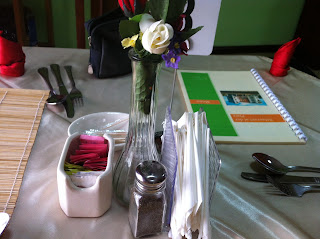My work is leading me more frequently to West Africa. I posted about Accra late last fall, and this time, I'll be reflecting on Liberia. The country is small in size, but has a rich and diverse cuisine that reflects the influence of various groups that interacted with the local population. Arabs brought cinnamon, mint and other spices, while the Americo-Liberians made their contributions, as well, bringing pound cake to the country's dessert table. This evolved into a cake that is spiced with ginger and cinnamon, a nice variation on the theme!
Still, there are some things that Liberia has in common with other West African countries. Ingredients such as tomatoes, palm oil, sweet potatoes, cassava leaves and a wide variety of seafood (including dried fish) are common in many recipes, often accompanied by massive portions of perfectly cooked rice. Liberians eat mashed cassava (fufu), but they are very serious about their rice!
My time in Monrovia -- which is Liberia's capital -- was pretty short. I was fortunate to be accompanied by Liberians who knew the best places to eat. I made sure to stress that I wanted to eat in locally owned restaurants that served Liberian cuisine. The hotel where I stayed caters to the international, Western crowd. I went the night that I arrived, expecting to find Liberian dishes on the menu, only to discover that 90% of the offerings were continental. I asked if my choices could be Liberianized in some way. That didn't work so well.
So I understood that I had to venture out to find local food. When I asked people for recommendations on where to eat, invariably I was told to go to Evelyn's on Broad Street.
It's a pretty simple place -- definitely not fancy. But bear in mind that Liberia is still recovering from two brutal civil wars. Because a place is simple doesn't mean that its food isn't delicious! People directed me to Evelyn's, which is a favorite with both Liberians and ex-pats.
It's good, solid Liberian food in a down-home, comfy environment!
The menu
is chock full of local favorites, which are usually spicy stews made with some kind of meat or fish cooked in a thick mixture of cassava leaves, palm oil, stock, and aromatic spices.
The menu is organized around daily specials. I went on Monday and ordered the cassava leaf. I was between meetings and my lunch companion made sure that the wait would not be long! About ten minutes after placing the order, the stew arrived. I wanted something that was all seafood, but that would have taken more time. So I contented myself with the beef-fish concoction that was way too big for one person to eat!
A large plate of perfectly cooked rice accompanied the stew
as did the ubiquitous, homemade pepper sauce, a variation of which is found throughout West Africa.
I love pepper sauce and devoured the entire plate. It is not for the faint of heart -- or for those who forget their Tums. Not kidding.
The stew was flavorful, heavy and filling. I left nearly half of mine. I wanted to leave room for dessert! My eye was captured by Liberian rice cake, which looks like a variation on an American carrot cake. But the texture is thicker, grainier, less sweet. And it's made with either bananas or sweet plantains. The waitress brought me a warm piece that was just crispy on the outside and softer on the inside. I smelled nutmeg and ginger as the spices.
I stupidly volunteered to share my dessert with my lunch companion. I could have eaten the entire piece myself!
A slightly more upscale place was located in The Rose Garden Plaza, a spanking new building that housed a travel agency.
Restaurant at der Platz is definitely more upscale than Evelyn's, and it had a much more extensive menu.
Unfortunately, the time we had for lunch was even more compressed! So instead of choosing based on what I really wanted to eat, I was guided by what was already ready!!
I chose fried fish (grouper), which came accompanied by a mountain of rice, onion sauce and .

sweet plantains. This one, however, was accompanied by palm oil-- which is very, very rich, aromatic and flavorful--and bean gravy.
I got a little carried away with the palm oil, forgetting about its richness. In Liberia, it's poured over the rice, which is then topped with the bean gravy.
One thing that struck me about Liberia's restaurants was how expensive they were! I saw little difference between the prices in Monrovia as compared to the United States! And consider that fact that the country is very poor. One wonders how average Liberians afford to eat out!
Most probably don't. They go to local markets like this one, located along the main road that goes to Sierra Leone:
This open-air market, like others in West Africa, sell spices, meat, fish, and produce. I wish that I had had more time to explore this one, but alas, I was on the way to the airport and had time for only a quick drive by.
I look forward to returning to Liberia. I hope to actually get into a kitchen and cook local food!!!










































































